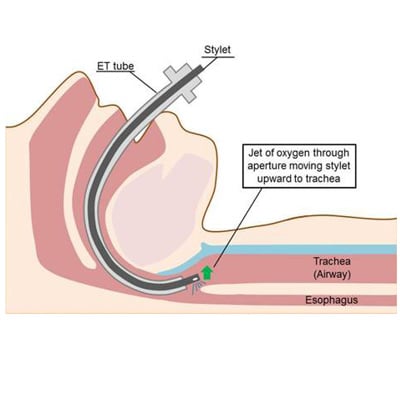
16MA021 Med Device: Novel Endotracheal Tube Intubating Stylet
The improved stylet precisely guides an Endotracheal tube (ET tube) into the airway of an anesthetized patient. A difficult or prolonged intubation can cause patient injury including tracheal laceration, hypoxia and death. This stylet uses pressurized oxygen and as opposed to the common rigid stylets, is soft and flexible to prevent patient injury. An additional benefit not offered by any other stylets is the delivery of much needed oxygen during intubation, essentially replacing an oxygen delivery device. These features give this stylet a competitive advantage in functionality and safety over competing devices on the market.
COMMERCIAL OPPORTUNITY
- Tracheal intubation is performed to establish mechanical ventilation in patients undergoing surgeries in the O.R and patients on ventilators the I.C.U. It has been estimated that there were about 25 million intubations performed in the US in 2010. The incidence of difficult tracheal intubations is reported to be as high as 23% and associated with hypoxia, aspiration and cardiac arrest.
- The Moffitt Stylet has a flexible soft tip that prevents patient injuries associated with the commonly used rigid stylets. The stylet that is most similar to the Moffitt stylet is the ‘Rapid Positioning intubation Stylet’ that shares the following features with the Moffitt stylet: a soft tip, a slimmer profile to allow a clear and unblocked view of the patient’s airway, and a user-controlled flexible tip. The Rapid Positioning intubation Stylet costs $40 leading to a potential US market for the Moffitt stylet of $230 million.
- An additional feature of the Moffitt stylet is the delivery of oxygen. During intubation, patients under anesthesia can’t breathe—prolonged oxygen deprivation can cause stroke and cardiac arrest, and continues to be a major and a preventable airway complication. The use of oxygen delivery devices like SuperNO2VATM and Optiflow ® is on the rise to help maintain oxygen levels, with Optiflow having a cost of $39. The Moffitt Stylet uses pressurized oxygen and becomes a two-in-one device to guide the ET tube into the trachea while simultaneously delivering oxygen to an oxygen-starved patient.
TECHNOLOGY
This new device is designed to facilitate intubation while preventing a drop in patient’s blood oxygen level, thereby taking the place of both a traditional stylet and an oxygen delivery apparatus. The distal tip of the stylet has an aperture at the bottom through which a jet of user-controlled oxygen escapes, flexing the stylet tip upwards and guiding into the trachea. Additionally the flexible and slimmer profile of the device protects against unwanted oral tissue damage to the patient seen with the commonly used rigid stylets.
PUBLICATION/PATENT
- Provisional patent filed for Dr. Tariq Chaudhry on September 6, 2016.
The Innovation Office
InnovationMarketing@Moffitt.org
(813) 745-6828

